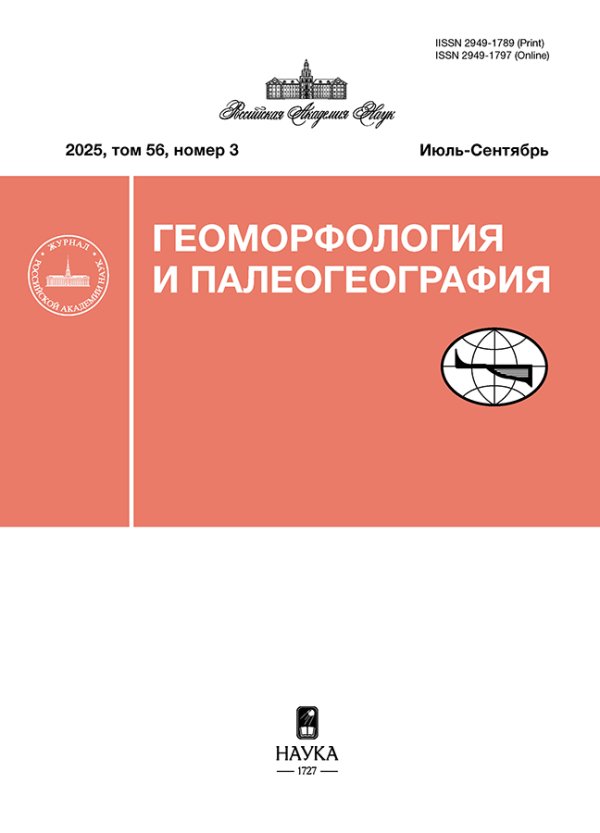MORPHOLOGY AND GENESIS OF UNDERWATER BARS AND RIDGES OF THE EAST SIBERIAN SEA4
- Authors: Sergeev A.Y.1, Ryabchuk D.V.1, Zhamoida V.A.1, Budanov L.M.1, Kovaleva O.A.1, Neevin I.A.1, Tokarev M.Y.2, Bashirova L.D.3, Ponomarenko E.P.3
-
Affiliations:
- Karpinsky Russian Geological Research Institute
- Lomonosov Moscow State University, Faculty of Geology
- Shirshov Institute of Oceanology of the Russian Academy of Sciences
- Issue: Vol 54, No 3 (2023)
- Pages: 26-38
- Section: SHORT COMMUNICATIONS
- URL: https://journals.rcsi.science/2949-1789/article/view/140581
- DOI: https://doi.org/10.31857/S294917892303009X
- EDN: https://elibrary.ru/WDUFPE
- ID: 140581
Cite item
Full Text
Abstract
Shelf zone of the East-Siberian Sea is one of the least studied marine areas of the Russian Arctic. One of the important unsolved problems is the existence of a ice sheet in the area of the New Siberian Islands, and the debate about the age and genesis of underwater ridges (bars). Based on geological and geophysical field work condicted by VSEGEI in 2018 and 2020, laboratory research, and data analyses, two types of submarine ridges, principally different in morphology, sediment composition, age, and genesis were identified. Ridges located within the submarine plain on the outer periphery of the submerged valley of the Pra-Kolyma river and around the New Sibir’ Island are asymmetric, have a relative height of 1–2 m to 4–6 m, an average width of 2–4 km (up to a few tens of km) and an average length of 25– 30 km (up to 100 km). According to the sampling data, the ridges of this type are composed of very dense clayey-silt without inclusion of coarse clastic material. The age of the deposits forming the ridges is Late Pleistocene (18–13 ka BP). Formations of the Upper Pleistocene age are exposed in the inter-ridge hollows. The composition, morphology, and age of the ridge deposits suggest that their genesis is associated with denudation processes, but the mechanism of their formation is not obvious. The second type of ridges includes a system of coastal bars located at a distance of up to 30 km from the coast of New Sibir’ Island and composed of fine-grained, well-sorted sands. The width of the ridges varies from 1 to 2 km, the height is from 4 to 8 m, and the length is 10–15 km. The ramparts have a slightly asymmetric shape, with a gentler slope from the side of the island. This system of ridges was formed as a result of accumulative processes in the Holocene. The obtained data do not support the hypothesis of the extension of the Late Pleistocene ice sheet to the shelf.
About the authors
A. Yu. Sergeev
Karpinsky Russian Geological Research Institute
Author for correspondence.
Email: sergeevau@yandex.ru
Russia, Saint Petersburg
D. V. Ryabchuk
Karpinsky Russian Geological Research Institute
Email: bas_leila@mail.ru
Russia, Saint Petersburg
V. A. Zhamoida
Karpinsky Russian Geological Research Institute
Email: bas_leila@mail.ru
Russia, Saint Petersburg
L. M. Budanov
Karpinsky Russian Geological Research Institute
Email: bas_leila@mail.ru
Russia, Saint Petersburg
O. A. Kovaleva
Karpinsky Russian Geological Research Institute
Email: bas_leila@mail.ru
Russia, Saint Petersburg
I. A. Neevin
Karpinsky Russian Geological Research Institute
Email: bas_leila@mail.ru
Russia, Saint Petersburg
M. Yu. Tokarev
Lomonosov Moscow State University, Faculty of Geology
Author for correspondence.
Email: mjtokarev@gmail.com
Russia, Moscow
L. D. Bashirova
Shirshov Institute of Oceanology of the Russian Academy of Sciences
Author for correspondence.
Email: bas_leila@mail.ru
Russia, Moscow
E. P. Ponomarenko
Shirshov Institute of Oceanology of the Russian Academy of Sciences
Email: bas_leila@mail.ru
Russia, Moscow
References
- Anisimov M.A., Tumskoy V.E., Savatyugin L.M. (2002). On the question of changes in the natural conditions of the Novosibirsk Islands in the Late Pleistocene and Holocene. Izvestiya Russkogo Geograficheskogo obshhestva. Vol. 134. Iss. 5. P. 32–37. (in Russ.)
- Bartova A.V. (2021). History of geological development of the lower reaches of the Kolyma in the Cenozoic. Geologiya i mineral’no-syr’evye resursy Severo-Vostoka Rossii: materialy XI Vserossiiskoi nauchno-prakticheskoi konferentsii, 05–07 aprelya 2021 g. Yakutsk: SVFU (Publ.). P. 11–14. (in Russ.)
- Basilyan A.E., Nikolsky P.A. (2007). On the Pleistocene glaciation of the Novosibirsk Islands. Geologicheskie sobytiya neogena i kvartera Rossii. Sovremennoe sostoyanie stratigraficheskikh skhem i paleogeograficheskie rekonstruktsii: materialy Vserossiiskogo nauchnogo soveshchaniya, Moskva, 27–30 marta 2007 g. Moscow: GEOS (Publ.). P. 10–12. (in Russ.)
- Bauch H.A., Mueller-Lupp T., Taldenkova E. et al. (2001). Chronology of the Holocene transgression at the North Siberian margin. Global and Planetary Change. Vol. 31. Iss. 1–4. P. 125–139. https://doi.org/10.1016/S0921-8181(01)00116-3
- Beloshapkov A.V., Gordin A.I., Ilyin V.V., Putov V.F. (2001). Accumulative forms of the coastal zone and shelf of northeastern Sakhalin. Humanity and the coastal zone of the world ocean in the XXI century. Moscow: GEOS. P. 126–140. (in Russ.)
- Cronin T.M., O’Regan M., Pearce C. et al. (2017). Deglacial sea level history of the East Siberian Sea and Chukchi Sea margins. Climate of the Past. Vol. 13. Iss. 9. P. 1097–1110. https://doi.org/10.5194/cp-13-1097-2017
- Degtyarenko Yu.P., Puminov A.P., Blagoveshchenskiy M.G. (1982). Coastlines of the Eastern Arctic seas in the Late Pleistocene and Holocene. Kolebaniya urovnya morei i okeanov za 15 000 let. Moscow: Nauka (Publ.). P. 179–185. (in Russ.)
- Dobrovolsky A.D., Zalogin B.S. (1982). Seas of the USSR. Moscow: MSU (Publ.). 192 p. (in Russ.)
- Dudarev O.V., Charkin A.N., Semiletov I.P. et al. (2007). Modern sedimentation on the near-continental shelf of the East-Siberian sea. Moscow: Nauka (Publ.). P. 382–391. (in Russ.)
- Grigoriev A.G., Zhamoida V.A., Spiridonov M.A. et al. (2009). New data on the history of the development of the southeastern part of the Baltic Sea from the Late Glacial period to the present. Regional’naya geologiya i metallogeniya. No. 40. P. 103–114. (in Russ.)
- Grigoriev M.N., Razumov S.O., Kunitsky V.V., Spector V.B. (2006). Dynamics of the shores of the Eastern Arctic seas of Russia: main factors, patterns and trends. Kriosfera Zemli. Vol. 10. No. 4. P. 74–94. (in Russ.)
- Imaeva L.P., Imaev V.S., Melnikova V.I. (2018). Stress-strain state of the newest structures of the North-Eastern sector of the Russian Arctic. Reports of the Academy of Sciences. Vol. 479. No. 2. P. 192–194. https://doi.org/10.7868/S0869565218080170
- Keigwin L.D., Donnelly J.P., Cook M.S. et al. (2006). Rapid sea-level rise and Holocene climate in the Chukchi Sea. Geology. Vol. 34. No. 10. P. 861–864.
- Klemann V., Heim B., Bauch H.A. et al. (2015). Sea-level evolution of the Laptev Sea and the East Siberian Sea since the last glacial maximum. Arktos. No. 1. https://doi.org/10.1007/s41063-015-0004-x
- Klyuvitkina T.S., Polyakova E.I. (2021). History of the Laptev Sea: why do paleogeographers need microalgae? Priroda. No. 6. P. 31–44. (in Russ.) https://doi.org/10.7868/S0032874X21060041
- Leont’ev I.O. (2014). Morfodinamicheskie protsessy v beregovoi zone morya (Morphodynamic processes in the coastal zone of the sea). LAP LAMBERT Academic Publishing. Saarbrücken, Deutschland / Germany. 251 p. (in Russ.). ISBN: 978-3-659-62831-3
- Leont’ev I.O., Ryabchuk D.V., Sergeev A.Yu., Sukhacheva L.L. (2011). On the genesis of some bottom and coastal features in the Eastern Gulf of Finland. Oceanology. Vol. 51. No. 4. P. 688–698. https://doi.org/10.1134/S0001437011040102
- Miroshnikov A.Yu., Flint M.V., Asadulin E.E. et al. (2020). Ecological state and mineralogical-geochemical characteristics of bottom sediments of the East Siberian Sea. Okeanology. Vol. 60. Iss. 4. P. 518–531. https://doi.org/10.1134/S0001437020040141
- Nikiforov S.L. (1985). Underwater accumulative forms on the shelf of the East Siberian Sea. Geologiya i geomorfologiya shel’fov i materikovykh sklonov. Moscow: Nauka (Publ.). P. 96–101 (in Russ.)
- Nikiforov S.L. (1989). The main features of the development of the shelf of the Chukchi and East Siberian Seas in the Late Pleistocene-Holocene time. Geomorfologiya. No. 3. P. 85–89 (in Russ.)
- Nikolaeva N.A., Derkachev A.N., Dudarev O.V. (2013). Features of the mineral composition of sediments of the shelf of the eastern part of the Laptev and East Siberian Seas. Okeanology. Vol. 53. Iss. 4. P. 472–480. https://doi.org/10.1134/S0001437013040073
- Ogorodov S.A. (2014). Rel’efoobrazuyushhaya rol' morskikh l’dov (The relief-forming role of sea ice). Prof. thesis. Moscow: MSU (Publ.). 44 p. (in Russ.)
- Pavlidis Yu.A., Leontiev I.O. (2000). Forecast of the development of the coastal zone of the East Siberian Sea with an increase in the level and warming of the climate. Vestnik RFFI. No. 1 (19). P. 31–39. (in Russ.)
- Petrovskaya N.A., Savushkina M.A. (2014). Comparison of seismic complexes and major inconsistencies in the sedimentary cover of the Eastern Arctic shelf. Neftegazovaya geologiya. Teoriya i praktika. No. 9. P. 1–26. (in Russ.)
- Pitulko V.V., Kuzmin Y.V., Glascock M.D. et al. (2019). They came from the ends of the earth’: long-distance exchange of obsidian in the High Arctic during the Early Holocene. Antiquity. No. 93 (367). P. 28–44. https://doi.org/10.15184/aqy.2019.2
- Reimer P.J., Austin W.E.N., Bard E. et al. (2020). The IntCal20 Northern Hemisphere Radiocarbon Age Calibration Curve (0–55 cal kBP). Radiocarbon. No. 62. P. 725–757. https://doi.org/10.1017/RDC.2020.41
- Rekant P., Bauch H.A., Schwenk T. et al. (2015). Evolution of subsea permafrost landscapes in Arctic Siberia since the Late Pleistocene: a synoptic insight from acoustic data of the Laptev Sea. Arktos. No. 11. https://doi.org/10.1007/s41063-015-0011-y
- Rekant P.V., Petrov O.V., Prishchepenko D.V. (2020). Formation of the fold-thrust structure of the southern part of the shelf of the East Siberian Sea based on the results of structural analysis of seismic materials. Regional’naya geologiya i metallogeniya. No. 82. P. 35–59. (in Russ.)
- Romanovsky N.N., Gavrilov A.V., Tumskoy V.E. et al. (1999). Thermokarst and its role in the formation of the coastal zone of the Laptev Sea shelf. Kriosfera Zemli. Iss. 3. No. 3. P. 79–91. (in Russ.)
- Sakulina T.S., Verba M.L., Kashubina T.V. et al. (2011). Complex geological and geophysical studies on the 5-AR reference profile in the East Siberian Sea. Razvedka i okhrana nedr. No. 10. P. 17–23. (in Russ.)
- Semenov Yu.P. (1965). On some features of the formation of bottom sediments of the East Siberian and Chukchi Seas. Antropogenovyi period v Arktike i Subarktike. Trudy NIIGA. Vol. 143. Moscow: Nedra (Publ.). P. 350–352. (in Russ.)
- Yashin D.S. (2000). Holocene sedimentogenesis of the Arctic seas of Russia. Geologo-geofizicheskie kharakteristiki litosfery Arkticheskogo regiona. No. 3. P. 57–67. (in Russ.)
- Zhamoida V.A., Sergeev A.Yu., Budanov L.M. et al. (2020). New data on the formation of Pliocene-Quaternary deposits of the Eastern Siberian Sea from the results of geological offshore mapping of R56-60 sheets of state geological map. Rel’ef i chetvertichnye obrazovaniya Arktiki, Subarktiki i Severo-Zapada Rossii. Iss. 7. P. 66–75. (in Russ.). https://doi.org/10.24411/2687-1092-2020-10710
Supplementary files















